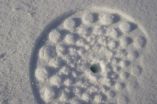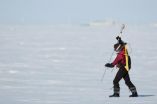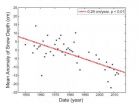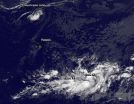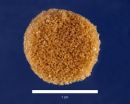(Press-News.org) From research stations drifting on ice floes to high-tech aircraft radar, scientists have been tracking the depth of snow that accumulates on Arctic sea ice for almost a century. Now that people are more concerned than ever about what is happening at the poles, research led by the University of Washington and NASA confirms that snow has thinned significantly in the Arctic, particularly on sea ice in western waters near Alaska.
A new study, accepted for publication in the Journal of Geophysical Research: Oceans, a publication of the American Geophysical Union, combines data collected by ice buoys and NASA aircraft with historic data from ice floes staffed by Soviet scientists from the late 1950s through the early 1990s to track changes over decades.
Historically, Soviets on drifting sea ice used meter sticks and handwritten logs to record snow depth. Today, researchers on the ground use an automated probe similar to a ski pole to verify the accuracy of airborne measurements.
"When you stab it into the ground, the basket move up, and it records the distance between the magnet and the end of the probe," said first author Melinda Webster, a UW graduate student in oceanography. "You can take a lot of measurements very quickly. It's a pretty big difference from the Soviet field stations."
Webster verified the accuracy of airborne data taken during a March 15, 2012 NASA flight over the sea ice near Barrow, Alaska. The following day Webster followed the same track in minus 30-degree temperatures while stabbing through the snow every two to three steps.
The authors compared data from NASA airborne surveys, collected between 2009 and 2013, with U.S. Army Corps of Engineers buoys frozen into the sea ice, and earlier data from Soviet drifting ice stations in 1937 and from 1954 through 1991. Results showed that snowpack has thinned from 14 inches to 9 inches (35 cm to 22 cm) in the western Arctic, and from 13 inches to 6 inches (33 cm to 14.5 cm) in the Beaufort and Chukchi seas, west and north of Alaska.
That's a decline in the western Arctic of about a third, and snowpack in the Beaufort and Chukchi seas less than half as thick in spring in recent years compared to the average Soviet-era records for that time of year.
"Knowing exactly the error between the airborne and the ground measurements, we're able to say with confidence, Yes, the snow is decreasing in the Beaufort and Chukchi seas," said co-author Ignatius Rigor, an oceanographer at the UW's Applied Physics Laboratory.
The authors speculate the reason for the thinner snow, especially in the Beaufort and Chukchi seas, may be that the surface freeze-up is happening later in the fall so the year's heaviest snowfalls, in September and October, mostly fall into the open ocean.
What thinner snow will mean for the ice is not certain. Deeper snow actually shields ice from cold air, so a thinner blanket may allow the ice to grow thicker during the winter. On the other hand, thinner snow cover may allow the ice to melt earlier in the springtime.
Thinner snow has other effects, Webster said, for animals that use the snow to make dens, and for low-light microscopic plants that grow underneath the sea ice and form the base of the Arctic food web.
The new results support a 15-year-old UW-led study in which Russian and American scientists first analyzed the historic Arctic Ocean snow measurements. That paper detected a slight decline in spring snow depth that the authors believed, even then, was due to a shorter ice-covered season.
"This confirms and extends the results of that earlier work, showing that we continue to see thinning snow on the Arctic sea ice," said Rigor, who was also a co-author on the earlier paper.
The recent fieldwork was part of NASA's Operation IceBridge program, which is using aircraft to track changes while NASA prepares to launch a new ice-monitoring satellite in 2017. The team conducted research flights in spring 2012 as part of a larger program to monitor changes in the Arctic.
INFORMATION:
The research was supported by NASA and the U.S. Interagency Arctic Buoy Program. Co-authors are Son Nghiem at NASA's Jet Propulsion Laboratory, Nathan Kurtz at NASA's Goddard Space Flight Center, Sinead Farrell at the University of Maryland, Don Perovich at the federal Cold Regions Research and Engineering Laboratory and Matthew Sturm at the University of Alaska Fairbanks.
For more information, contact Webster at melindaw@uw.edu and Rigor at 206-685-2571 or ignatius@apl.washington.edu. Webster is on travel until late August but will have email access at least once a day.
More images are available at http://bit.ly/snowdepth_images
Snow has thinned on Arctic sea ice
2014-08-13
ELSE PRESS RELEASES FROM THIS DATE:
New progress in long bone fracture evaluation using ultrasound
2014-08-13
A recent study illustrated that the mode conversion of the ultrasonic guided waves can quantitatively reflect the fracture degree of long cortical bone, which may provide new method for long bone fracture evaluation and healing monitoring.
This scientific paper (Quantitative evaluation of long bone fractures by ultrasonic guided waves) is published on SCIENCE CHINA Physica, Mechanica & Astronomica (in Chinese), 2014, 44(7). Professor TA De-an from school of information science and technology, Fudan university leads this study. The impacts of fracture width and depth on ...
Flexible tapes from the nanoworld
2014-08-13
Porphyrin molecules are essential to many biological processes, such as photosynthesis and respiration. Dr. Wilhelm Auwärter's group is investigating these all-round talents at TU München.
Normally, hydrogen attaches to the outer edges of the porphyrin core – named porphine, but other chemical entities can take the place of hydrogen, thereby changing the properties of the molecules.
Alissa Wiengarten, PhD student at the TUM Department of Physics, heats a porphine powder in a vacuum chamber. In the process, individual porphine molecules leave the collective and adhere ...
Teachers play key role in program to fight childhood obesity
2014-08-13
An innovative physical activities guide developed at the Frank Porter Graham Child Development Institute (FPG) is helping North Carolina fight childhood obesity. New research shows that when teachers direct these physical activities, young children become more active and less sedentary.
"In the past twenty years, childhood obesity rates have skyrocketed," said FPG investigator Allison De Marco. "And for the first time in over a century, children's life expectancies are declining because of increased numbers of overweight kids."
De Marco said these statistics are especially ...
Researchers uncover clues about how the most important TB drug attacks its target
2014-08-13
Researchers at the Johns Hopkins Bloomberg School of Public Health say they have discovered a new clue to understanding how the most important medication for tuberculosis (TB) works to attack dormant TB bacteria in order to shorten treatment.
The antibiotic Pyrazinamide (PZA) has been used to treat TB since the 1950s, but its mechanisms are the least understood of all TB drugs. The PZA findings may help researchers identify new and more effective drugs not only for TB – which can require six months or more of treatment – but other persistent bacterial infections. A report ...
Hurricane Julio and 2 tropical lows 'bookend' Hawaii
2014-08-13
Infrared satellite imagery from NOAA's GOES-West satellite shows three tropical system s in the Central Pacific Ocean that appears like bookends with Hawaii in-between.
In an infrared image from the GOES-West satellite taken August 13 at 1200 UTC (8 a.m. EDT/2 a.m. HST), Hurricane Julio lies to the north of Hawaii, while two low pressure areas lie to the southeast of the island state. The image was created by NASA/NOAA's GOES Project at NASA's Goddard Space Flight Center in Greenbelt, Maryland.
On August 13 at 0900 UTC (5 a.m. EDT/11 p.m. HST on Aug.12) the center of ...
How useful is economics -- how is economics useful?
2014-08-13
What insights do the models, experiments and econometric regressions of scientific research provide about the economy – and why and under what conditions are they useful in dealing with real-world problems? This question will be overarching the discussions among 17 Nobel Laureates in Economic Sciences and approximately 450 aspiring young economists from more than 80 countries in Lindau, Germany, next week. The 5th Lindau Meeting on Economic Sciences will bring them together for a unique dialogue across generations, cultures and scientific backgrounds. The meeting will open ...
Many older emergency department patients are malnourished
2014-08-13
More than half of emergency department patients age 65 and older who were seen at UNC Hospitals during an 8-week period were either malnourished or at risk for malnutrition.
In addition, more than half of the malnourished patients had not previously been diagnosed, according to a new study by researchers at the University of North Carolina at Chapel Hill. The study was published online August 13 by the journal Annals of Emergency Medicine.
"Malnutrition is known to be a common problem among older adults. What is surprising in our study is that most of the malnourished ...
Reduction of tau protein improves symptoms in model of severe childhood epilepsy
2014-08-13
Researchers at the Gladstone Institutes have shown that reducing brain levels of the protein tau effectively blocks the development of disease in a mouse model of Dravet syndrome, a severe intractable form of childhood epilepsy. This therapeutic strategy not only suppressed seizure activity and premature death, but also improved cognitive and behavioral abnormalities that can accompany this syndrome.
Previous studies from this group have shown that lowering tau levels reduces abnormal brain activity in models of Alzheimer's disease, but this is the first demonstration ...
'Shape-shifting' material could help reconstruct faces
2014-08-13
SAN FRANCISCO, Aug. 13, 2014 — Injuries, birth defects (such as cleft palates) or surgery to remove a tumor can create gaps in bone that are too large to heal naturally. And when they occur in the head, face or jaw, these bone defects can dramatically alter a person's appearance. Researchers will report today that they have developed a "self-fitting" material that expands with warm salt water to precisely fill bone defects, and also acts as a scaffold for new bone growth.
The team will describe their approach in one of nearly 12,000 presentations at the 248th National ...
Dust -- and the microbes hitching rides on it -- influences rain, climate
2014-08-13
SAN FRANCISCO, Aug. 13, 2014 — Dusty air blowing across the Pacific from Asia and Africa plays a critical role in precipitation patterns throughout the drought-stricken western U.S. Today, a scientist will present new research suggesting that the exact chemical make-up of that dust, including microbes found in it, is the key to how much rain and snow falls from clouds throughout the region. This information could help better predict rain events, as well as explain how air pollution from a variety of sources influences regional climate in general.
She will present a talk ...
